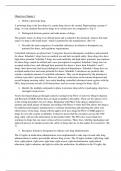Objectives Chapter 1 1. Define a prototype drug. A prototype drug is the first drug of a certain drug class to be created. Representing a group of drugs, it is the standard that newer drugs in its certain class are compared to. (Pg 3) 2. Distinguish between generic and trade names of drugs. The generic name of a drug is its official name and is related to the chemical, whereas the trade name of a drug is the brand name - which is patented by the manufacturer. (Pg 3 -4) 3. Describe the main categories of controlled substances in relation to therapeutic use, potential for abuse, and regulatory requirements. Controlled substances are placed into 5 categories based on therapeutic usefulness and potential for abuse. Schedule 1 drugs have no medical use and l ack accepted safety; these drugs also have high abuse potential. S chedule 2 drugs are used medically and high abuse potential - prescriptions for these drugs cannot be refilled and a new prescription is required. Schedule 3 drugs have an accepted medical use, and although their potential for abuse is lower than Schedule 1 and 2 drugs, their abuse may lead to psychological or physical dependence. Schedule 4 drugs have an accepted me dical use and some potential for abuse. Schedule 5 substances are products that contain a moderate amount of controlled substances . They can be dispensed by the pharmacist without a provider’s prescription . However , there are restrictions on the amount dispensed and record keeping ensuring safety. Any entity handling controlled substances must register with the DEA, keep accurate records of all transactions, and use secure storage for them. (Pg 6) 4. Identify the multiple safeguards in place to promote drug safety in packaging, drug laws, and approval processes. Newly developed drugs go through extensive testing by the FDA’s Center for Drug Evaluation and Research (CDER) before they are made available to the public. There are five phases (0 -4) in the testing procedures for new drugs. Beginning with Phase 0 the drug is administers to animals and small groups of humans and ending with Phase 4 where the FDA allows the drug to be marketed and requires manufactures to continue monitoring and reporting the safety and effectiveness of the drug. Along with the approval of new drugs the FDA’s CDER approves drugs for over-the-counter availability. It must be shown that the consumer can use the OTC drug safely with just the information on the product label . The FDA also issues black box warnings to drugs that can cause serious adverse reactions. These laws, labeling (packaging) and approval process for market ensures the safety of drugs that are on the market for consumers. (Pg 7) 5. Recognize initiatives designated to enhance safe drug administration. The 10 rights of medication administration were implemented to take steps toward safer drug administration to reduce preventable adverse drug events. The 10 rights include: right drug, right dose, right patient, right route, right time, right reason, right documentation, right patient education, right evaluation, and right to refuse the medication. In addition to the 10 rights, the




